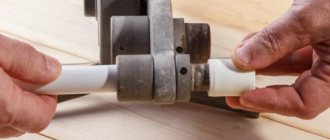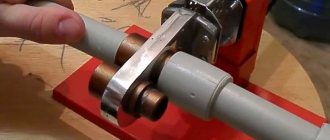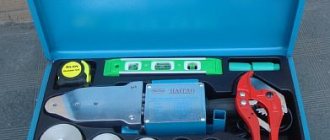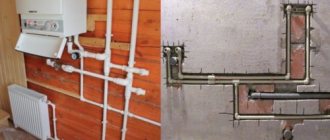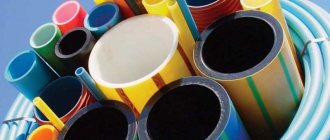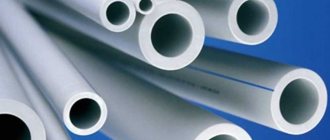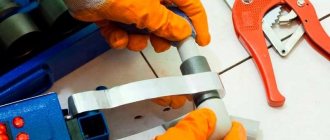Plastic (aka plastic) and any other artificial polymers have gained great popularity in our country over the past 30 years. Everything is made from plastic: from dishes to pipes. For this reason, manufacturers offer a wide variety of tools for the job. You can now purchase plastic welding equipment to perform both amateur repairs and professional plastic welding. The simplest plastic welding kit will allow you to quickly and relatively inexpensively solder pipes, for example.
But due to the wide variety of tools, welders are often unable to choose a tool that will satisfy their professional needs. Therefore, we decided to briefly tell you what tools you can use to weld plastic parts.
Types of equipment
Nowadays, buying equipment for welding plastic is a matter of five minutes. You don’t even have to leave your home and order the device from an online store. But how to choose among such a variety of machines for welding plastic and not make a mistake? Next, we will talk about the types of devices for welding plastics, and in conclusion we will share our opinion regarding the choice of a device for beginners.
Welding hand gun
A hand-held welding gun is the simplest, and therefore the most popular, device for welding plastic products. Manufacturers offer hundreds of models that differ only in ergonomics and power. Regardless of the price, the essence of the work of a welding gun is always the same: it heats the solder and edges to the melting temperature to form a permanent connection. Solder is applied to the junction of two parts (usually a rod made of the same plastic as the parts themselves) and heated to the melting temperature. The solder fills the joint between the parts and, as it cools, a seam is formed.
The design of a welding hair dryer is very similar to a regular household hair dryer. The difference is that the welding device is made of more durable materials and is capable of heating plastic to a temperature of 500 degrees Celsius. This temperature is more than enough if you need fast and high-quality welding of plastic.
Welding guns can have manual or automatic heat control. Automatic is useful for beginners who do not have sufficient experience. But manual adjustment will be appreciated by professionals who know all the intricacies of high-quality work.
Hair dryers may also have special attachments that can be used to direct hot air. With the help of such nozzles, various connections are made: both overlapping and butt. In stores you can find nozzles of various diameters and with different nozzle shapes.
Industrial and household welding guns are on sale. Industrial hair dryers have high power and heating temperature, they are better assembled and, in general, allow you to perform most jobs: from welding polymer fabrics to welding pipe shells. Household hair dryers do not have such wide capabilities, but they are inexpensive and can be used to perform simple repairs.
Welding extruder
A welding extruder for welding plastics is a hand-held welding device that looks like a gun. The essence of its work is simple: first, a plastic rod is inserted into the extruder, which is then heated to the melting temperature, and then the molten plastic is squeezed out to the joint. Imagine that you are joining two parts using superglue. Only the parts are made of plastic, and the tube is a welding extruder, from which not glue is extruded, but molten plastic.
The molten layer of plastic quickly hardens, forming a strong connection. At the same time, the extruder has several advantages that welding guns lack. For example, thick parts can be welded in one pass. Because of this, welding productivity is several times higher. And the extruder welding technology itself is extremely simple.
The only drawback is the ability to weld only parts from the same types of plastic. You will not be able to weld parts that have a different chemical composition or melting point. And this drawback narrows the possibilities of welding. Also, the surface of the parts must be prepared before welding so that they are better connected to each other.
Contact welding machine
This is a whole group of devices based on the use of contact welding technology. Resistance welding is a method of joining metals and polymers by exposing them to a short-term thermal pulse and slight mechanical pressure. Machines for resistance welding of plastic are not used in home welding, but they can often be found in factories.
Such devices allow you to work quickly and efficiently, the connection is strong and durable. Often, plastic sheets are used as blanks, which is why such devices are also called machines for welding plastic sheets.
Professional welding machines
Sometimes, for plastic, equipment must meet the highest standards so that the connection is not only durable, but also airtight. A professional welding machine can handle this task.
Contact devices
Contact devices include devices that combine heating of the parts being connected and a small mechanical impact. It is advisable to use them when carrying out industrial work. The connection when used is durable and reliable. Such devices are often used when it is necessary to join plastic sheets.
The peculiarity is that the heat supply is not constant, and each impact is for a short period of time.
Types of plastic that can be welded
Not all types of plastic retain their properties when melted and then cooled. It is impossible to weld plastic that is afraid of heat. These types of polymer materials are called thermosets. They are flammable, when heated they begin to smoke, and at high temperatures they burn and char.
Only thermoplastics are welded well, the most common of which are PVC (polyvinyl chloride), polyethylene and polypropylene. Other types of heated plastics are usually glued or mounted on a lathing. This:
- nylon;
- polyvinyl acetate;
- polycarbonate;
- polyethylene terephthalate;
- polystyrene
The welding process is possible if the parts are made of homogeneous plastic. The format does not play a special role. The parts can be joined over the entire thickness or through a third of the layer; with a smaller seam, the adhesion of the parts is considered unreliable. Pipe products are often installed with an overlap. This connection has a large adhesion area.
Plastic welding methods and equipment
Several methods are used for soldering plastic at home.
- Contact welding for plastic is the most convenient. Does not require filler material. The simplest of them is a household soldering iron with an operating voltage of 220 volts with a special nozzle instead of a tip; it provides a large heating area. The contact method is considered universal; it connects polypropylene and polyethylene of various densities, shapes and thicknesses. The essence of the process is heating the seam area to 260°C and then joining the parts by butting or overlapping. There are three types of equipment for welding plastics: 1) when the heating element acts on the entire thickness of the part (for sheet and pipe plastic); 2) the heating zone is limited (overlapping sheets); 3) the inner and outer parts of the elements being connected are simultaneously heated (socket joint).
Connecting parts with hot air using a heat gun or a heat gun allows you to use a filler rod; it is supplied manually. The principle of operation of the equipment is simple: air from the electric heater is forced by a fan through a narrow opening into the heating zone. The polymer melts and a seam is formed. A hairdryer with a nozzle is more convenient than a pistol; the rod is tucked into the nozzle, and the left hand is freed. For home use, a heat gun or hair dryer with a power of 1.5 or 2 kW is often purchased. It heats the air from +180°C to +260°C, models are equipped with thermostats.
- Joining parts with an extruder involves feeding molten polymer into the area where the parts are joined. This method is the simplest and most reliable; after welding, an even seam bead is formed.
- non-contact, when the supplied mass must be leveled with a special roller;
- contact, when a soft polymer is fed with force.
Extruders are available in two types:
The adjustment is carried out taking into account the type of polymer and the thickness of the filler rod.
TOP 10 best machines for welding plastic pipes by price and quality
The power level, heating strength, the presence of nozzles, holders, as well as other properties of welding machines are important to maintain correct operation. The use of the unit in everyday life at elevated temperatures must be safe and justified. Therefore, you need to know which criteria are important.
Kolner KPWM 800MC
An inexpensive welding machine with a power of 800 W and a maximum heating temperature of 300 °C. The device is designed for manual socket welding with a diameter of no more than 32 mm, equipped with a durable Teflon coating that is not subject to excessive overheating.
The kit includes several replaceable attachments, a convenient stand holder, and a case for storing the device.
Kolner KPWM 800MC
- Low cost.
- High quality build.
- Overheat protection function.
- The set includes several welding attachments, a screwdriver, and a storage case.
- Unstable stand.
RESANTA ASPT-1000
A good welding machine designed for connecting socket-type plastic pipes. Equipped with an adjustable thermostat. The power of the device is 1000 W, the maximum heating temperature is 300 °C. The set includes six different attachments and a convenient handle holder.
Perfectly suitable for use in domestic conditions. There is a reliable storage case. The device itself is coated with a thermally protective Teflon coating, which prevents excessive overheating or unwanted damage.
RESANTA ASPT-1000
- Six universal replaceable attachments.
- Wide range of diameters of welded pipes.
- Easy and safe to use.
- Thermostat to control heating temperature.
- Unreliable stand with no adjustment options.
CANDAN SM-06
The welding machine is supplied in a reliable metal case along with various attachments, a tape measure, a screwdriver, and a high-quality pipe cutter. The maximum welding diameter of pipes is 40 mm, the critical heating temperature is 320 °C.
The sword-shaped shape of the steam heater ensures reliable soldering of polypropylene pipes in everyday life. The cost and ease of use of the device set this model apart from other competitors.
CANDAN SM-06
- Functionality.
- Low price.
- Excellent factory equipment.
- Power up to 1500 W.
- Heavy.
Wester DWM 1000B
An excellent machine for welding plastic pipes, which is equipped with a rich set of nozzles of various diameters (from 20 to 63 mm). Light weight and ergonomic design allow the unit to be used even in hard-to-reach places.
The device also includes a tape measure, a screwdriver, gloves and a pipe cutter. Protection is provided against excessive heating of the treated surface, which prevents excessive melting or burning of plastic pipes. The device is convenient for independent use at home; it does not require excessive skills and effort from the owner.
Wester DWM 1000B
- Simplicity and comfort of use.
- Variety of nozzles by type and diameter.
- Good original equipment.
- Provides a tight connection of pipes.
- There is no manual temperature control.
CALIBER SVA-2000T
Powerful pipe welding machine with a performance of 2000 W and a heating temperature of 300 °C. The built-in thermostat allows you to regulate the required temperature, and the setting tool optimizes the soldering process. A wide range of interchangeable nozzles allows you to select the one you need even when working with narrow pipes with a diameter of up to 20 mm.
The kit includes a storage case, a tape measure, a pipe cutter, and a holder stand for the device. Suitable for home use when soldering water pipes.
CALIBER SVA-2000T
- Many attachments: from 20 to 63 mm.
- Excellent set of additional working tools.
- Metal case for storing the device.
- Convenient stand for fixed work.
- Relatively heavy weight - 5 kg.
Special PTP-1000
The device with a paired sword-type welding nozzle allows you to solder socket joints. Lightweight and compact, it is easy to store and use. An ergonomic case with various components increases the functionality of the device.
The kit includes six different welding attachments and a special key for changing them. The device is of the household type, as it does not have high power and soldering frequency. Safe to use - does not cause excessive melting or stickiness of plastic materials.
Special PTP-1000
- Convenient case with a well-thought-out storage system.
- Light weight.
- Large set of specially coated attachments.
- Detailed operating instructions.
- Unreliable stand without fastening.
DIOLD ASPT-4
Welding machine coated with heat-resistant Teflon and replaceable nozzles of various diameters. The power of the device is 1500 W with a heating temperature of 300 °C. The main nozzle of a pair type with a sword-shaped heater ensures safe soldering of plastic pipes without burning and stickiness of the material.
The kit includes a tape measure, gloves, and a screwdriver. A warranty period of 12 months is provided, under which you can repair or replace a broken device. The weight of the device is 1 kg, which makes it easy to store and carry.
DIOLD ASPT-4
- Well equipped.
- Light weight, compact size.
- 6 replaceable welding attachments.
- Full 1 year warranty.
- The kit does not include a pipe cutter.
ELITECH SPT 1500
A machine for welding plastic pipes with excellent factory equipment: a metal storage case, 6 welding attachments, protective gloves, a tape measure, a screwdriver and a pipe cutter. There is an adjustable thermostat to help control the operating temperature. The device is intended for household use.
The power of the device is 1500 W, temperature – 300 °C. The input voltage is 220 W, and the soldering frequency is 50 Hz. The type of the main nozzle is of the pair type, which ensures safe, gentle heating of polypropylene compounds.
ELITECH SPT 1500
- The set contains 6 nozzles with a diameter of 20-63 mm.
- Teflon coating of the device.
- Thermostatic type of heating temperature control.
- Thoughtful storage system.
- Quite a lot of weight - 6 kg.
RESANTA ASPT-2000
One of the best machines for welding plastic pipes according to owner reviews. The kit includes six different welding attachments along with a screwdriver for changing them, as well as heat-resistant gloves and a durable storage case. The maximum heating temperature is 300 °C, and the soldering frequency is 50 Hz.
The device is intended for use at home for socket-type soldering of plastic pipes. A durable and high-quality welding machine will be an excellent assistant when laying communications.
RESANTA ASPT-2000
- Excellent build quality.
- Low price.
- Has two power modes (1000W, 2000W).
- Not subject to excessive overheating.
- The storage case has an unstable coating - rust may occur.
Sturm! TW7219
Welding machine for plastic pipes with a sword-shaped heater. Provides socket welding without blackening and stickiness of the material. The kit includes 6 nozzles with a diameter of 20-63 mm, a tape measure, protective gloves, a screwdriver and a pipe cutter. Supports standard 220W input power as well as 50Hz soldering frequency.
Designed for household use and storage. The weight of the device itself is 1 kg, the weight of a complete set of tools is 4.78 kg. High-quality assembly ensures high performance and long service life.
Sturm! TW7219
- Excellent availability of necessary tools.
- Light weight.
- Six different attachments.
- Maximum power – 1900W.
- Ergonomic case for storage and carrying.
- Unreliable stand.
Technology of welding plastics with a hairdryer or heat gun
The method is used for products of any configuration. A hairdryer can be used to install pipes, bumpers, swimming pools, flooring and much more.
A plastic welding hairdryer can be used to join any thermoplastics. The gun is more often used to join parts with overlaps: the space between them is heated, after which the seam is compacted and rolled with a roller. They also connect parts using a hair dryer; when the products are joined end-to-end, a filler rod is fed into the seam area - it is directed over the joint or into it. Now about the nozzles, a construction hair dryer for rod welding simultaneously heats the edges and the filler material. Hair dryer attachments are divided into types:
- fixing ones press the surfaces to be welded before welding;
- slotted ones are convenient for welding roofing materials;
- forming ones are used for rods thicker than 4 mm.
The technology for making a seam involves pre-processing the edges: they are cleaned and degreased. Edges thicker than 2 mm are first chamfered to make room for laying the rod. When joining thin plastics, the rod is fed directly into the gap between the parts. It must be taken into account that with the use of filler material a convex weld is formed. If necessary, excess polymer is cut off. To form an even connection, it is necessary to maintain a distance between the hair dryer and the parts being connected. The speed of the hair dryer is adjusted so that the rod and edges have time to warm up, but do not melt too much. There should be no edge deformation.
Extruder welding technology for plastics
Of all the hot methods, the most economical and convenient is the connection of plastic elements with a contact extruder, when the molten mass fed into the joint is pressed by a guide nozzle. This method is used for parts with thick walls. The extruder feeds already softened material. With this method:
- energy consumption decreases;
- heat transfer improves;
- there is no need to use clamping devices;
- it is easier to control the quality of the seam.
Main stages of the technological process:
- Heating the welded edges to a state of viscosity with a heated mass;
- Docking by hand force or special devices;
- Natural cooling of the connected parts (they cannot be moved until they have completely hardened).
Selection of welding rods
The filler material is selected according to the type of plastic being welded. It is indicated in the labeling. Polypropylene filler rods are available in different sections: triangular, round. If the parts are fastened at right angles, it is better to choose a triangular rod. They vary in color. Black and gray are in great demand. Polyethylene rods for welding plastic are softer than polypropylene rods, the melting point is lower (from +160°C).
Filler materials are used at ambient temperatures above +15°C. In the cold they lose their plasticity and become brittle.
When choosing an additive, you need to pay attention to the melting point of the rod or rods. It is acceptable to use slightly different polymers if they are similar in their plasticity regime. It is important that the filler material fits well into the extruder and matches the diameter of the loading hole and outlet nozzle. For manual extruders, rods or rods from 2 to 7 mm are used.
Thermo-contact welding of plastic
It is also contact-thermal.
This technology for welding plastics involves the use of a heated welding tool, upon contact with which the surfaces being joined are heated. Depending on the selected equipment, there are two options for such welding:
- The heating element fits tightly to the parts being connected. As a result, he melts them.
- The heating element is in contact only with the external parts of the products being welded. As a result, they melt.
Thermo-contact welding method is one of the most accessible and universal methods. It uses special automated equipment that operates in a fully automatic mode. For example, this could be a line for bottling milk into bags.
The price of equipment for thermal contact welding is quite high. But experience with its use shows that it is largely justified by its high productivity and profitability.
Professional devices
To perform large-scale work (for example, to create covers for large greenhouses), it is best to use professional devices for welding polyethylene film. The advantage of such devices is that with them you can adjust the parameters of pressure, temperature and the speed at which it will move along the seam.
If you need to connect sections of polyethylene from the same batch, then once you have set the necessary parameters, the welding process can be carried out very quickly. Typically, such tools are equipped with drive and tension rollers, thanks to which it is possible to pull the film sheets being welded at the same speed. This ensures high seam quality.
Today, there are various types of industrial devices on the market. They can have both contact heating and heating, which is produced by means of hot air.
The quality of polyethylene welds significantly exceeds the strength and reliability of areas that were connected using adhesive materials.
To summarize, it is worth noting that welding polyethylene at home is not as difficult as it seems at first glance.
For this purpose, various devices are provided with which you can obtain a high-quality and durable connection. A soldering iron and iron will help you create a seam in a short time, the main thing is to maintain the accuracy of the technology. If large-scale work is to be done, then it is better to give preference to professional industrial devices.
In any case, the final result will depend on your efforts and care. Also remember that when performing welding work, do not forget about personal safety; gloves and protective clothing will not be superfluous, but, on the contrary, will protect you from accidental burns. If you have no experience at all, then it is certainly better to turn to specially trained people.
[Total votes: 1 Average: 4/5]
- Date: 08/29/2015 Rating: 12
In the modern world, polyethylene film is widely used. We often encounter the fact that in some types of work it is necessary to tightly connect individual pieces of polyethylene film. For example, for arranging greenhouses and greenhouses, for creating vapor barrier layers during construction.
Welding of this material may also be required in domestic situations. Sometimes a tight connection plays a decisive role when carrying out certain activities. Gluing polyethylene with tape or special adhesives does not provide airtight and durable joints, so in critical cases, where high-quality waterproofing is needed, the welding method is used.
Figure 1. Diagram of the nozzle. Welding of polyethylene refers to the joining of individual layers of material by heating to the melting temperature and compression of the layers to form a weld. During the period of melting of the film surface, the layers are connected at the molecular level, as a result, after cooling, a monostructure is formed in the body of the weld.
The joint strength coefficient is approximately 0.7-0.85. That is, 70-85% of the original strength of the polyethylene being welded. Under ideal conditions, the coefficient can be higher, but this requires special equipment, purity of the material and selected heating temperature. The melting temperature of polyethylene film is approximately 120-160°C and depends on its application. If contaminated surfaces are welded, the strength characteristics of the joint are reduced, since impurities enter the molten mass, disrupting the molecular structure in the seam. To obtain a high-quality and durable joint, the following is required conditions:
Figure 2. Diagram of the iron attachment. uniformity of the pieces of film being welded (meaning it belongs to the same production batch); cleanliness of the surfaces being joined; selected temperature conditions (if underheated, the strength drops sharply, and with overheating, deformation of the joint and the pre-seam area is possible); application of the required compression during heating. For high-quality connections, it is not allowed to re-weld pieces along the same edges; in such cases they are cut off. Most often in everyday life and during construction operations, the following methods of connection by heating are used: welding using a soldering iron (may include the use of nozzles); joining as a result of heating and melting of layers films with an iron; heating with a burner; using special industrial devices to create a seam. Return to contents Joining polyethylene sheets using a conventional soldering iron (40-60 W) allows you to get a strong seam, which will require minor modification of the tool. Using a soldering iron without special attachments will not give a high-quality result .
The joint will be uneven, and there may be places where the material will spread. Joining layers of film with a soldering iron without nozzles can be recommended for small amounts of work (for example, emergency repair of a torn part of polyethylene). Scheme for welding film. To obtain a good result and weld joints of significant length, the use of additional devices will be required. There are several options for modifying the soldering iron. Take a regular soldering iron, then remove the end of the tip. Using a hacksaw, a cut is created.
After this, a copper or aluminum plate is inserted into the cut and secured with a rivet. The surface of the plate is processed, its edges are rounded with a file. Welding is carried out by slightly pressing the soldering iron at an angle of 45° and moving it evenly. Temperature and pressure are selected experimentally.
When creating a joint, it is recommended to place a flat wooden or textolite substrate under the bottom layer of the film, and center the soldering iron on a flat bar. In some cases, thin paper will be placed between the plate and the film. This is relevant if thin film is being welded. After creating the seam, the paper is carefully separated. An approximate sample of the nozzle is shown in Fig. 1 (1 - plate; 2 - soldering iron and its rod). Diagram of ultrasonic welding. One of the nozzle options involves the use of a wheel.
To do this, the end of the tip is removed, a cut is created slightly larger than the radius of the wheel. A hole is drilled in the body of the tip for the desired wheel axis (3-5 mm), after which a disk is made of aluminum or copper (8-10 mm). The disc is inserted into the slot of the tip and secured with an axle. It is possible to install the disk in a separate tube-tip, and it, in turn, is put on the soldering iron tip. Welding pieces of film is carried out by rolling a heated soldering iron to the required distance.
The amount of pressure is adjusted depending on the welding of the seam. This method allows you to carry out a significant amount of work. Return to contents The next popular method is to melt the film and create a joint using an iron. The advantage of this method is that large areas of the film can be welded in this way, while creating the desired seam width.
Since any iron has a thermal relay and the ability to regulate the temperature, it is not difficult to select the required thermal mode for polyethylene of various thicknesses. The welding process is best carried out on a smooth wooden surface. Pieces (sheets) of film are overlapped, the width of which is selected individually, then the top layer is covered with paper or a fluoroplastic sheet, after which it is pressed and the iron is drawn along the welding line. The pressing force, speed and temperature are selected experimentally. Fig. 2 shows a convenient nozzle for an iron, with which you can obtain a double welding seam (1 - base; 2 - contact wedges; 3 - brackets for attaching to the sole of the iron). The nozzle is made of brass, copper or aluminum. Return to contents For large-scale work (for example, to create coverings for large greenhouses or for commercial activities), it is recommended to use professional polyethylene welding devices.
The advantages of these devices are that they allow flexible adjustment of parameters of pressure, temperature, and speed of movement along the seam. If you are working with the same batch of polyethylene, then once you have set the required values, you can carry out the welding process at high speed. Welding devices often have drive and tension rollers that allow you to pull the film sheets being joined at the same speed, which has a beneficial effect on the final quality of the seam. Industrial devices are produced in various types. They can have contact heating or heating carried out by hot air. Welded sections of polyethylene film have much better strength characteristics compared to sections of polyethylene connected using adhesive materials. Actions with large areas of material are economically advantageous when choosing a connection by welding, since there is no need in adhesives or tape. Productivity and accuracy of work increases significantly.
The low melting point and flexibility of the material allows the connection to be made by welding at home. The resulting strength of the joint mainly depends on the temperature and cleanliness of the surfaces being joined.November 24303 views49 ratingWelding of polyethylene can be carried out both in ordinary and industrial conditions. Its implementation is most popular when creating coverings for greenhouses, where pieces of material are joined using contact heating.
Soldering may also be needed for book covers, packaging bags, and other needs. Scheme of film welding. Welding of polyethylene film is done by bringing the polymer material into a viscous state. To do this, its edges are heated to a temperature at which melting begins, then they must be connected and squeeze tightly. To do this correctly, you can use a device specially designed for this purpose for welding polyethylene. The operation of such devices can be carried out in several modes, which are set depending on the thickness and characteristics of the polymer and its type.
Welding in an electric field
The operating principle of this type of welding is based on the absorption of energy from an electric field. It cannot be used for all types of plastic, but only for the so-called polar ones. These include:
There are two main schemes for this type of welding: press and roller. Their main difference lies in the method of laying the seams.
Currently, this type of welding has reached significant perfection. It is widely used in the production of shoes, writing instruments and even railway cars. Among the main advantages of this type of welding, the following should be especially noted:
- High performance indicators.
- Economical.
- Possibility of combining a number of other technological operations with the welding process.
Thanks to the above advantages, the high-frequency welding method is developing and improving very quickly. Currently, quite a few equipment options have been developed for this type of welding. Some of them even went into mass production.
Welding with gas coolant using an additive
With this method, a special rod for welding plastic is used as an additive. Using a jet of heated gas, the welded surfaces and the rod itself are heated. After which the welder presses the rod tightly with his hand. As a result, the welded surfaces are connected.
This method is very versatile. It can be used to weld plastics of any thickness and in any configuration. All types of connections can be made using this method: overlap, butt and corner. Among its disadvantages, it is worth noting the relatively low performance.
Welding film with a household iron
This method is widely popular.
First you need to prepare: for this, a wooden block is placed on the table, and the edges of the film panels are placed on it. Here it is important to ensure that the ends of the material protrude 20 mm from the edges of the bar. A refractory sheet material, such as cellophane or fluoroplastic film, is placed on top of the polyethylene panels.
In order for the process to proceed faster, after you pass the iron over the film, the area to be welded must be cooled, for example, you can use a wet rag.
It is important to control the temperature of the thermostat: it should be 120-150 °C.
The sheets of film need to be folded overlapping, and then a paper sheet should be laid on them. After this, the iron must be tilted 5° and slowly moved along the seam. You won’t be able to get a strong connection the first time; you need to repeat the sequence of actions 4-5 times.
Welders experienced in this matter often use special attachments that are fixed to the electric iron.
The nozzle has a flat ribbed base. It is the ribs that are responsible for connecting sections of polyethylene film. In the soldering area, with the help of a nozzle, two strong seams are formed, placed in parallel.
Welding polyethylene film using a soldering iron
By using a regular soldering iron (40-60 W) to join the film, you can get a strong and reliable seam, but you need to improve the tool a little. Using a soldering iron without special attachments will not lead to the desired result, because...
Because the joint will turn out uneven, and the material may even spread. That is why you need to use special attachments that are attached to the device.
You need to take a regular soldering iron, remove the end of the tip, use a hacksaw to create a cut and place an aluminum or copper plate in it and secure it with a rivet.
The surface of the plate must be processed and rounded on all sides with a needle file. The welding process itself is carried out as follows: the soldering iron is pressed at an angle of 45° and moves evenly over the parts being welded. In the process of creating a joint, experts recommend placing a wooden base under the film.
A wheel can also be used as an attachment. To do this, the end of the tip is also removed and a cut is created that is larger than the radius of the wheel.
A hole is drilled in the body of the tip for the desired wheel axis (3-5 mm), after which an aluminum or copper disk (8-10 mm) is made. The disc is placed in the recess of the tip and fixed by the axis. The welding process itself consists of rolling a heated soldering iron to the required distance.
Friction welding of plastics
This method is based on the property of converting mechanical energy at the point of friction into thermal energy. Due to this, heating of the welded surfaces occurs. Friction welding is used mainly for joining products made of hard plastics. This method is very simple in its technological essence. It is enough for him to have access to a conventional drilling or lathe. Among its disadvantages, it is worth noting that one of the parts must have a round surface.
Professional equipment
Equipment for welding joints of plastic products at a professional level meets the requirements of high standards, which ensures a weld with impeccable characteristics.
This type of equipment is used for connecting products with complex configurations. These include, in particular, pipeline elbows.
Ultrasonic welding of plastics
Recently, the ultrasonic method of welding plastics has become increasingly widespread.
It allows for high-quality connection of parts of various thicknesses. A modern ultrasonic plastic welding machine allows plastic films to be welded continuously and at very high speeds. When equipped with an additional working tip, it also becomes possible to carry out welding in manual mode.
comparison table
Due to the fact that there are a large number of machines for welding plastic pipes on the market, it is not always possible to immediately understand what exactly you need. To do this, we have made a table where you can clearly compare all the models that are included in the rating.
| Model | Power, W | Number of attachments included | Device weight, kg | Average price, rub |
| Kolner KPWM 800MC | 800 | 3 | 1 | 980 |
| RESANTA ASPT-1000 | 1000 | 6 | 2,85 | 1 580 |
| CANDAN SM-06 | 1500 | 4 | 5 | 2 559 |
| Wester DWM 1000B | 800 | 6 | 3 | 2 199 |
| CALIBER SVA-2000T | 2000 | 5 | 2 460 | |
| Special PTP-1000 | 980 | 1 | 2 190 | |
| DIOLD ASPT-4 | 1500 | 1 | 3 255 | |
| ELITECH SPT 1500 | 1500 | 5 | 3 099 | |
| RESANTA ASPT-2000 | 2000 | 4,65 | 2 630 | |
| Sturm! TW7219 | 1900 | 1 | 2 920 |
Consumables for plastic welding
Manual welding of plastic is impossible without the use of filler material. It is produced in the form of special rods. Welding rods are rods made of polyethylene or propylene. They are also sometimes called electrodes.
Their main difference is the cross-sectional shape. The most commonly used rods are those with a round cross-section, but in addition to them, rods with a triangular or oval cross-section are also used. In addition, electrodes for welding plastic vary in diameter. Most often, options with a diameter of 3 or 4 mm are used. You can buy electrodes in specialized stores that sell consumables for welding.
